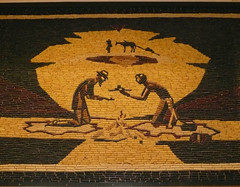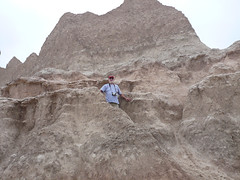 ll of the murals which adorn the walls in the auditorium (see pic it right). All the murals are made entirely of half ears of corn, which is specially planted and hand-picked after it is dried in the fields. There are 11 colors of corn available to the designers of the murals each year.
ll of the murals which adorn the walls in the auditorium (see pic it right). All the murals are made entirely of half ears of corn, which is specially planted and hand-picked after it is dried in the fields. There are 11 colors of corn available to the designers of the murals each year.But what I really want to talk about in this blog is the land and the crops and my impressions of what I'm seeing. It seems, in my memory, that from the time we started in Indiana, until halfway across Minnesota, landforms were the same, flat, with some gentle rises you could not call hills. This land was covered with obviously rotating crops of corn and soybeans. Fields extending as far as the eye could see on each side of the highway. All the corn fields I have seen before this trip combined would not equal one of these fields. Sitting high in the RV, I get a different perspective than I would from a car, and that may contribute to my feeling of the endlessness of these fields. Anyway, I was awed.
While I was on the phone talking with my son Erik, we came upon the Missouri River as it swings north through eastern South Dakota. While talking, I was moving from place to place in the RV to get different views of that beautiful valley. The river was wide and beautiful, but the impression I got from driving into the Valley was overwhelming. We were going downhill fairly steeply and ahead of us across the river was a slope of land up to an escarpment. This slope was covered with dark and light grasses and evergreen trees of dark green color. I know no camera could record what I was seeing at that moment.
Somewhere in central North Dakota, the corn crop ceases to exist. Suddenly, or so it seemed, we were into grass country. Huge fields of hay crop were visible on each side. In some of the fields, the large round bales had been left where they fell and just scattered over the landscape. In others, the bales have been gathered into long rows, seemingly placed on the crest of ridges. I have no idea why a farmer would choose one or the other. It's curious how sometimes I want some information, and I have no idea where to get it.
I began to see a beautifully colored landscape. In the fields where the winter wheat had been cut, there remained a golden stubble. In the fields where the grass was still growing, there was a tawny sea with ripples working through the tall grasses. Once in awhile, there would be a deep green field where an unknown crop was growing very low to the ground. Lastly, there was rich, black earth of fields already turned from last year's winter wheat and ready for planting this year's. Further west, there were fewer fields of wheat and the landscape became hillier. Herds of beef cattle dotted the hillsides.I was surprised by how few herds were purebreds. There were black cattle with white faces, Angus with red or brown tones in their black bodies, and black cows being followed by white calves. The land was very dry, and in the valleys between hills, there were earthen dams to create waterholes.
I was fascinated by the Cheyenne River Valley. Along the winding, meandering river, on both banks were small trees, not more than 20 feet tall, which I assumed were cottonwoods. It seems in my memory, then every Western book or movie, has a scene in the cottonwoods along the river. Anyway, the Cheyenne River Valley brought to life my preconceptions of what that looks like. On the edges of the river valley was an escarpment, a sharp rise from the floor of the river valley to a plateau 30 or 40 feet higher. It was like flooding had washed away the land to a distance far wider than the current river. These old river banks were now covered with grasses and bushes that were many shades of tan, yellow and green. It was a really refreshing scene for the eyes.
In my last blog, I forgot to mention a sight that greeted me as we cross the Mississippi from Wisconsin and Minnesota. We were traveling on Interstate 90. The road surface was concrete. As with many concrete roads, the two lanes were separated by a crack. The novel thing was that this small crack was filled with grass! I expect grass in the middle of the back roads of Vermont, but not on Interstate 90!

We toured the Badlands of South Dakota yesterday (see pic it right). I'm really not sure what to say. First, it is a scene of destruction due to severe water erosion. Second, it reminded me on my trip through the Southwest, where the Grand Canyon and others are due to the same causes. It is a wasteland.beautiful in its own way. The depth of the canyons (?) was awe-inspiring and a mite frightening when you got near the edge. Mostly, I love the way the layers of sediment were revealed by the erosion. Each layer has a distinct color from gravies tan is to red brown's to rosy red's. Up close (see pic), I discovered it's composed of sandstone with a lot of play in it. As the sandstone erodes, that clay slides down the face of the hills and when you walk on it, fills the treads of your shoes. It is also slippery when wet. We traveled along the heights of part of the Badlands so we could look down into the canyons and then we traveled along the base of part of the Badlands so we could look up through the small valleys cut into the rock. In one section, I was sure I had seen a distinct yellow coloration in the rock. As I tried to photograph it while we were moving (a hopeless task), I realized that the yellow came from the grasses that were growing on the low slopes of the eroded hills. It blended in so perfectly. I thought it was rock.
Last night we went to Mount Rushmore to see the lighting of the famous carvings. None of the pictures of the lighting came out, but some different perspectives on mode is usually shown can be seen in the pics here. I enjoyed it, but my host loved it again.

1 comment:
Great job - really like how you are getting more of you in the posts vs. the somewhat dry travelogue narration at the beginning. Makes me feel like I'm sharing it with you as opposed to just reading notes and captions.
Post a Comment